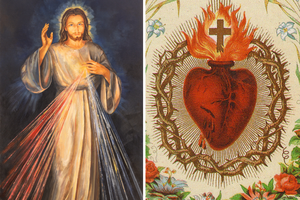Following Faustina’s Footsteps
World Youth Day 2016’s Mercy Message

ST. FAUSTINA’S POLAND. The Divine Mercy saint and founder of World Youth Day, St. John Paul II, were seen all around Krakow. Filip Mazurczak photo
Many interpreted the choice of Krakow, Poland, for World Youth Day 2016 as a tribute to Pope St. John Paul II, whose pastoral experience in Krakow inspired him to create a recurring event that shows the Church’s youth and dynamism.
It was clear that John Paul II would be one of the “co-stars” of the Krakow edition of the event. In the Polish city, it was clear that the festival was also a tribute to St. Faustina Kowalska, the Polish nun and mystic who brought the Church the Divine Mercy devotion.
In the days leading up to World Youth Day, “Days in the Dioceses” were held. In all Polish dioceses, an excess of 130,000 young people saw Polish Catholicism at the local level. In the pre-WYD events, St. Faustina played an important role.
In the city of Lodz, about 1,500 pilgrims participated in the “Road of Mercy,” a trail leading from Wenecja Park to the archdiocesan cathedral. It is the path that Helena Kowalska, who would become Sister Faustina, walked when she first came to Lodz and Jesus spoke to her.
The walk featured numerous stations, during which pilgrims listened to brief meditations on St. Faustina’s diary and watched pantomime performances related to the Crucifixion.
The connection to St. Faustina in World Youth Day was also evident in the official World Youth Day theme and hymn, Blest Are the Merciful.
The song is a meditation on Matthew 5:7, and its chorus is: “Blest are the merciful; blest are the merciful, for it is mercy that shall be shown to those who show mercy.”
Meanwhile, in Legnica, an oratorio (large-scale musical work) was prepared by a local seminarian. This work, which was performed by an orchestra and chorus of 100, featured 17 musical pieces, interspersed with biblical quotes as well as quotes from St. John Paul II, Cardinal Stefan Wyszyski (the heroic primate of Poland from 1948 to 1981, known for his steadfast opposition to communism and efforts to rekindle the Poles’ faith) and St. Faustina.
Meanwhile, in Plock — where St. Faustina had her first apparition of Jesus — Mayor Andrzej Nowakowski gave young pilgrims keys to the city, calling it “the city of Divine Mercy.”
The pilgrims in Plock watched a musical-poetic film presenting St. Faustina’s stay in the city titled The Song of Faustina: Love’s Middle Name Is Mercy.
In Sokółka, in the Bialystok Diocese, in a parish where an alleged Eucharistic miracle occurred in 2008 and is now being investigated by the Vatican, pilgrims were able to see one of the two original paintings of Divine Mercy that were made according to St. Faustina’s vision.
Other cities that organized Faustina-related events were Siedlce, where a field game — whose purpose was to find “St. Faustina’s secret” — using GPS was held, and Chełmza, in the Torun Diocese, where local youths ran in a “Mercy Marathon.”
Also ahead of World Youth Day, a youth choir in Nowy Sacz recorded its rendition of the sung Divine Mercy Chaplet for use during World Youth Day.
And at the opening Mass for World Youth Day on July 26, Cardinal Stanisław Dziwisz, archbishop of Krakow, referenced St. Faustina: “Krakow is alive with the mystery of Divine Mercy, also thanks to the humble Sister Faustina, who heeded the Church’s and the world’s attention to this particular trait of God. When you return to your countries, homes and communities, carry the spark of mercy and remind everyone that ‘Blessed are the merciful, for they will receive mercy.”
In the heart of Krakow, St. Faustina was tangibly present. Throughout the city, there were banners containing the World Youth Day logo and alternating photos of Pope St. John Paul II and St. Faustina in a Pop Art-esque aesthetic, making clear that St. Faustina and the Divine Mercy devotion were crucial to the event.
There were also posters showing cartoon-like depictions of St. Faustina and, presumably, St. John Paul II (who in reality looked like Pope St. John XXIII) and the following message in Polish, Spanish and English: “How many times shall I forgive my brother? Until [sic] seventy-seven times.”
Appropriately, amid the celebration of the Year of Mercy, the references to St. Faustina at Krakow’s WYD permeated the air at every corner.
Filip Mazurczak filed this report from Krakow, Poland.
- Keywords:
- divine mercy
- poland
- st. faustina
- st. john paul ii
- world youth day
- world youth day krakow
- year of mercy

















